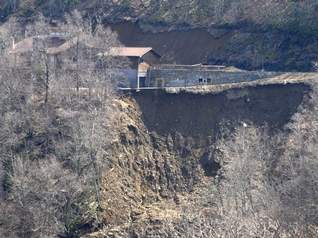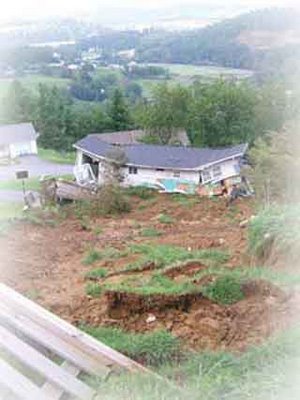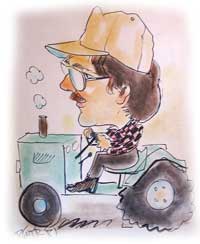Subscribe to
Posts [Atom]
Monday, August 31, 2009
Book Review
Taking a break from American history reading, I decide to learn a little something about evolution and delve into one of the most exciting books I’ve read in years, “The Song of the Dodo” by David Quammen. It’s a relatively old book, published in the mid-’90s, but it’s all new to me and written with the wry zip of a born cut-up. Couldn’t put it down.
The book is named for the dodo because that bird was one of hundreds of island species that went extinct not so terribly long ago, about the end of the 17th century. It had evolved without the need for wings – no natural predators, until Europeans arrived on Mauritius and found it easy pickin's. Quammen records that the name “dodo” possibly comes from a nickname given it by Dutch sailors, meaning (roughly) “lard ass.”
Ole Lard Ass opens the door to a history of the study of evolution. Charles Darwin got himself to islands to discover the species that began to open his eyes, as did Alfred Russel Wallace, Darwin’s chief rival for the claim of thinking up the “origin of species.” Quammen assumes that Wallace got to the truth first but received no credit for it, partly because he was a rank amateur and Darwin was the revered professional. “Islands give clarity to evolution,” says Quammen: “Islands have been especially instructive because their limited area and their inherent isolation combine to make patterns of evolution stand out starkly.”
Quammen is not a mere armchair adventurer. He’s followed the footsteps of those pioneering biologists, petted the marine iguanas of the Galapagos, hunted the invasive brown tree snakes in the dark of Guam, nearly had his butt amputated by a Komodo dragon on the island of Flores in the nation of Indonesia. Those and dozens of other eye-witness accounts enliven this book.
If the sum total of Quammen’s reportage is melancholy, and if you’re particularly susceptible to the ecological blues, you might want to focus on the subtitle of this book before plunging in: “Island Biogeography in an Age of Extinctions.” Scientists who study ancient bones have charted a series of five mass extinctions of species going back to the late Ordovician period (440 million years ago), followed by one in the late Devonian period (370 million years ago) and then the Permian extinction 250 million years ago, which eliminated more than half the extant families of invertebrate marine creatures, and the mass extinction at the end of the Triassic period (about 215 million years ago) and then the Cretaceous extinction 65 million years ago, which claimed the last of the dinosaurs. Human life had no hand in any of these because human life did not yet exist.
But in the later millennia of the Pleistocene epoch, only tens of thousands of years ago, a sixth mass extinction of animals got underway and is still continuing today, helped along by the appetites and hobbies of mankind, since this most recent extinction began about the time that humans began hunting in armed and cooperative packs.
“Eons in the future,” Quammen sums up, “paleontologists from the planet Tralfamadore will look at the evidence and wonder what happened on Earth to cause such vast losses so suddenly at six points in time: at the end of the Ordovician, in the late Devonian, at the end of the Permian, at the end of the Triassic, at the end of the Cretaceous, and again about sixty-five million years later, in the late Quaternary, right around the time of the invention of the dugout canoe, the stone ax, the iron plow, the three-masted sailing ship, the automobile, the hamburger, the television, the bulldozer, the chain saw, and the antibiotic.”
FOOTNOTE
Quammen’s section on the extinction of the passenger pigeon is especially poignant, since these mountains harbored so many millions of them up through much of the 19th century. They gave their names to hundreds of places called “Pigeon Roost” in Ohio, Indiana, and in Watauga County, N.C., among dozens of other places. They were “harvested” by the thousands by teenage boys and by their fathers as a kind of prank, knocked off their roosts at night with sticks. It was so easy, killing them. The last confirmed wild passenger pigeon was shot dead in Sargents, Ohio, on March 24, 1900. The very last known, formerly wild passenger pigeon died in the Cincinnati Zoo in 1914.
The book is named for the dodo because that bird was one of hundreds of island species that went extinct not so terribly long ago, about the end of the 17th century. It had evolved without the need for wings – no natural predators, until Europeans arrived on Mauritius and found it easy pickin's. Quammen records that the name “dodo” possibly comes from a nickname given it by Dutch sailors, meaning (roughly) “lard ass.”
Ole Lard Ass opens the door to a history of the study of evolution. Charles Darwin got himself to islands to discover the species that began to open his eyes, as did Alfred Russel Wallace, Darwin’s chief rival for the claim of thinking up the “origin of species.” Quammen assumes that Wallace got to the truth first but received no credit for it, partly because he was a rank amateur and Darwin was the revered professional. “Islands give clarity to evolution,” says Quammen: “Islands have been especially instructive because their limited area and their inherent isolation combine to make patterns of evolution stand out starkly.”
Quammen is not a mere armchair adventurer. He’s followed the footsteps of those pioneering biologists, petted the marine iguanas of the Galapagos, hunted the invasive brown tree snakes in the dark of Guam, nearly had his butt amputated by a Komodo dragon on the island of Flores in the nation of Indonesia. Those and dozens of other eye-witness accounts enliven this book.
If the sum total of Quammen’s reportage is melancholy, and if you’re particularly susceptible to the ecological blues, you might want to focus on the subtitle of this book before plunging in: “Island Biogeography in an Age of Extinctions.” Scientists who study ancient bones have charted a series of five mass extinctions of species going back to the late Ordovician period (440 million years ago), followed by one in the late Devonian period (370 million years ago) and then the Permian extinction 250 million years ago, which eliminated more than half the extant families of invertebrate marine creatures, and the mass extinction at the end of the Triassic period (about 215 million years ago) and then the Cretaceous extinction 65 million years ago, which claimed the last of the dinosaurs. Human life had no hand in any of these because human life did not yet exist.
But in the later millennia of the Pleistocene epoch, only tens of thousands of years ago, a sixth mass extinction of animals got underway and is still continuing today, helped along by the appetites and hobbies of mankind, since this most recent extinction began about the time that humans began hunting in armed and cooperative packs.
“Eons in the future,” Quammen sums up, “paleontologists from the planet Tralfamadore will look at the evidence and wonder what happened on Earth to cause such vast losses so suddenly at six points in time: at the end of the Ordovician, in the late Devonian, at the end of the Permian, at the end of the Triassic, at the end of the Cretaceous, and again about sixty-five million years later, in the late Quaternary, right around the time of the invention of the dugout canoe, the stone ax, the iron plow, the three-masted sailing ship, the automobile, the hamburger, the television, the bulldozer, the chain saw, and the antibiotic.”
FOOTNOTE
Quammen’s section on the extinction of the passenger pigeon is especially poignant, since these mountains harbored so many millions of them up through much of the 19th century. They gave their names to hundreds of places called “Pigeon Roost” in Ohio, Indiana, and in Watauga County, N.C., among dozens of other places. They were “harvested” by the thousands by teenage boys and by their fathers as a kind of prank, knocked off their roosts at night with sticks. It was so easy, killing them. The last confirmed wild passenger pigeon was shot dead in Sargents, Ohio, on March 24, 1900. The very last known, formerly wild passenger pigeon died in the Cincinnati Zoo in 1914.
Labels: evolution, Watauga County
Monday, June 22, 2009
Watauga ... Most Under-Insured County in N.C.
According to the U.S. Census, in 2005 Watauga County had the highest percentage of uninsured people in the whole state of North Carolina ... some 31 percent (hat-tip: MEM). Some 49 other N.C. counties had over 20% of their residents uninsured. Those numbers are probably higher now.
Meanwhile, N.C. Senator Kay Hagan is dicking around with the future of the public health, trying her best to find a way to pump even more money into the gigantic boondoggle of the for-profit private insurance rip-off, while denying her constituents any true shot at basic health-care insurance reform.
Meanwhile, N.C. Senator Kay Hagan is dicking around with the future of the public health, trying her best to find a way to pump even more money into the gigantic boondoggle of the for-profit private insurance rip-off, while denying her constituents any true shot at basic health-care insurance reform.
Labels: health care, Kay Hagan, Watauga County
Tuesday, May 05, 2009
Polling on Landslide Hazards
 The survey of Watauga County voters about land development issues reported on in yesterday's Watauga Democrat might, in the best of all possible worlds, lead to some new public policy.
The survey of Watauga County voters about land development issues reported on in yesterday's Watauga Democrat might, in the best of all possible worlds, lead to some new public policy.Nearly all of the 402 people surveyed -- 95 percent of them -- believe property buyers should be forewarned about landslide hazards.
Duh.
And in this county particularly, there are now very thorough landslide hazard maps available ... though no ordinance requiring the information in them to be shared or acted on. The real estate industry is dead set against it.
Labels: polls and polling, steep slope hazards, Watauga County
Sunday, March 01, 2009
'Til the Landslide Brings Us Down
 Watauga County gets prominent mention in a lengthy Asheville Citizen-Times report titled "Homes in Harm's Way on Many WNC Slopes." In that currently rarest activity in some of the newspapery world, Citizen-Times reporters actually did some investigation. They "examined hundreds of erosion inspection reports, reviewed a state database of known landslides, examined maps of landslide hazard areas and interviewed environmentalists, builders, real estate brokers, state legislators and government scientists." And found, among other things, that almost 1,000 homes and 300 undeveloped lots are in the path of potential landslides in Watauga County.
Watauga County gets prominent mention in a lengthy Asheville Citizen-Times report titled "Homes in Harm's Way on Many WNC Slopes." In that currently rarest activity in some of the newspapery world, Citizen-Times reporters actually did some investigation. They "examined hundreds of erosion inspection reports, reviewed a state database of known landslides, examined maps of landslide hazard areas and interviewed environmentalists, builders, real estate brokers, state legislators and government scientists." And found, among other things, that almost 1,000 homes and 300 undeveloped lots are in the path of potential landslides in Watauga County.Since 1990 six people have died, five have been injured, and 40 homes and buildings have been destroyed in 534 landslides and debris flows across western North Carolina.
The state Geological Survey completed the mapping of hazardous slopes in Watauga, but so far "officials there have made no changes to land development laws in response to the state's mapping" ... no required disclosure to buyers of property that landslide hazards are known to exist and no required engineering to require new building on known hazardous slopes to compensate for the risk.
And nothing's likely to change until Mother Nature once again shows her power. If history is any guide, it'll take another back-to-back hurricane event, like Frances and Ivan of 2004, and some property owners will be given great cause to rue that nothing was done to prevent loss of life and property when something could have and should have been done.
Labels: steep slope hazards, Watauga County
Monday, November 10, 2008
Watauga, Jackson & Buncombe -- Oh My!
 Asheville Citizen-Times reporter Joel Burgess takes an extended look this a.m. at why three lone North Carolina counties in the western mountains went for Obama, while all around them was red hot for McCain/Palin. Answer: young voters. All three counties contain a major state university.
Asheville Citizen-Times reporter Joel Burgess takes an extended look this a.m. at why three lone North Carolina counties in the western mountains went for Obama, while all around them was red hot for McCain/Palin. Answer: young voters. All three counties contain a major state university.Didn't your mother always warn you that a little larnin' was a dangerous thing?
Interesting factoids:
Of the Democratic-leaning counties, Watauga has the largest percentage of 18- to 25-year-old voters — 31.3 percent. Jackson is next with 15.4 percent, then Swain with 12.7 percent and Buncombe with 11.6 percent. Obama won all but Swain by differences as large as 57-43 percent.
We got us a new Generation Gap, folks!
Labels: Barack Obama, Buncombe County, Generation Gap, Jackson County, Watauga County
Monday, November 03, 2008
Watauga Early Voting, Final Numbers
One-Stop Early Voting = 17,783 voters
Mail-in Absentee ballots = 1,107
Overseas ballots = 15
Military absentee = 37
Sorry, no analysis from us at this hour, but at least one thing is plenty obvious: the virtual tie between Rs and Us in Early One-Stop Voting.
Dem 6,676 ... 37.54% of the total
Rep 5,568 ... 31.31% of the total
Una 5,506 ... 30.96% of the total
Lib 33 ... .00185% of the total
Mail-in Absentee ballots = 1,107
Dem 294
Rep 571
Una 242
Overseas ballots = 15
Dem 4
Rep 6
Una 5
Military absentee = 37
Dem 7
Rep 21
Una 9
Sorry, no analysis from us at this hour, but at least one thing is plenty obvious: the virtual tie between Rs and Us in Early One-Stop Voting.
Labels: early voting in North Carolina, Watauga County
Saturday, June 28, 2008
More Early-Voting Stations in Watauga
We hear that there will be a total of five early-voting polling stations in Watauga County come October 16, when North Carolinians can begin casting votes in the general election this fall.
We hear talk that there will be new early-voting stations at the Boone Mall, at the Western Watauga Community Center, and on the Appalachian State University campus, in addition to the two stations that have been used for several election cycles at the Agricultural Conference Center and in the Board of Elections office in the County Courthouse.
We hear talk that there will be new early-voting stations at the Boone Mall, at the Western Watauga Community Center, and on the Appalachian State University campus, in addition to the two stations that have been used for several election cycles at the Agricultural Conference Center and in the Board of Elections office in the County Courthouse.
Labels: early voting in North Carolina, Watauga County
